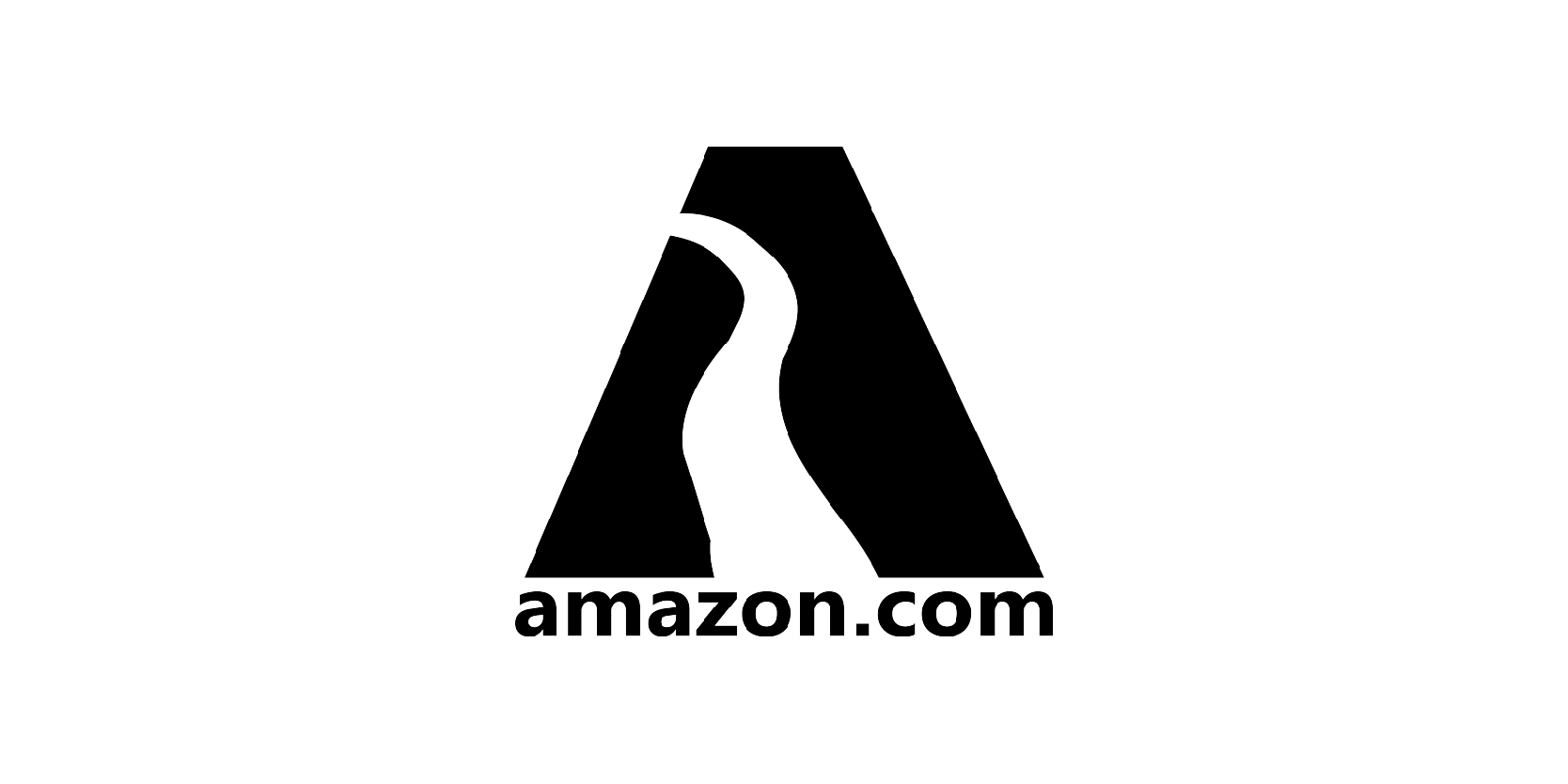Over the past three decades, Amazon has transformed from a small online bookstore into one of the world’s most influential companies and its logo has evolved alongside its journey. The Amazon logo is more than just a visual identified; it’s a reflection of the brand’s growth, values, and vision.
From its early, text-heavy designs in the mid 1990s to the now-iconic logo featuring the signature arrow pointing from A to Z, each change tells a story about the company’s expanding ambitions and customer-focused approach.
By looking at the history of Amazon’s logo, we can uncover how strategic design updates have helped shape its identity, and make it instantly recognizable.
Debate of a new company: 1995-1997

This early Amazon logo, used between 1995 and 1997, reflects the company’s beginnings as an online bookstore. The design features a large, bold, black capital “A” with a winding white path cutting through its center, symbolizing the Amazon River.
This imagery subtly connects the brand to its namesake, the world’s largest river, representing vastness, exploration, and abundance. The minimalist black-and-white palette gives it a professional, no-frills appearance, suitable for a young internet company finding its footing in the mid-90s digital landscape.
Below the emblem, “amazon.com” is written in a clean, sans-serif font, clearly highlighting the company’s identity as an online business. Unlike today’s warm, friendly branding, this version feels more corporate and symbolic, focusing on building recognition and credibility in the early days of e-commerce.
It’s a reminder of Amazon’s humble origins before it evolved into the globally dominant brand we know today.
Temporary design: 1997

This Amazon logo, used in 1997, marked the company’s first step toward a more refined and distinctive brand identity. The bold capital “A” remains the centerpiece, but the design has been reimagined with sleek, wavy white lines running through it, still evoking the image of the Amazon River, but with a more modern, and stylized look.
Below the emblem, “Amazon.com” is presented in a thick, black, sans-serif typeface, making the brand name instantly recognizable and clearly tied to the internet era. Compared to the 1995 version, this logo feels more dynamic and confident, signaling Amazon’s evolution from a niche online bookstore into a broader online retailer ready to compete in the rapidly expanding digital marketplace.
It’s a transitional design, still carrying symbolic roots, but moving closer to the sleek, user-friendly branding Amazon is known for today.
A complete new look: 1997-1998

This Amazon logo, used from 1997-1998, marked a shift toward a cleaner and more text-focused brand identity. The bold serif typeface in all lowercase letters gave “Amazon.com” a professional yet approachable look, while the tagline “Earth’s Biggest Bookstore” emphasized the company’s primary focus at the time, dominating the online book retail space.
By dropping earlier graphic-heavy elements and leaning into typography, Amazon projected clarity and trustworthiness, important traits for an emerging e-commerce brand in the late 1990s.
This minimalist design also made the logo adaptable for different digital and print applications, foreshadowing Amazon’s future approach of simplicity paired with strong messaging. It’s a snapshot of Amazon at a pivotal stage, still a specialist in books but already hinting at ambitions beyond them.
Trying out new things: 1998

This 1998 Amazon logo represented a major step in the company’s visual evolution, moving away from a purely text-based style to a more modern, brandable look. The all-uppercase, sans-serif font conveyed confidence and authority, while the bold golden “O” in the center served as a distinctive visual hook.
The circular “O” wasn’t just a stylistic flourish, it symbolized global reach and hinted at Amazon’s growing ambition beyond books. By removing the tagline “Earth’s Biggest Bookstore,” Amazon signaled that it was no longer limiting itself to one market. This clean, contemporary design gave the brand a stronger digital identity, making it more memorable in the rapidly expanding online marketplace.
It was a transitional moment: Amazon was no longer just an online bookstore, it was positioning itself as a one-stop shop for everything.
Reshaping its current identity: 1998-2000

The 1998-2000 logo started to shape its modern logo look, and what changed significantly here is that the distinctive golden “O” from the earlier 1998 design was removed and replaced with a fully streamlined wordmark. The logo used a black, bold sans-serif typeface in all uppercase letters, giving it a clean, modern, and professional appearance.
By dropping the decorative “O”, Amazon leaned further into simplicity, focusing on clarity and readability across all digital platforms. The removal also reflected a more mature brand identity as the company expanded its product offerings well beyond books and positioned itself as a comprehensive online retailer.
This minimalist approach made the logo more versatile for different media, ensuring consistent recognition as Amazon’s presence grew globally. While short-lived, this version served as a bridge between the experimental designs of the 1990s and the iconic, customer-friendly branding introduced in 2000.
Modernization: 2000-2024

From 2000-2024, Amazon introduced the now-iconic logo that became synonymous with the brand’s global dominance. This design featured the word “amazon” in a clean, lowercase sans-serif font, with a bold yellow arrow curving from the letter “a” to “z.”
The arrow wasn’t just a graphic flourish, it was a clever visual metaphor. It symbolized that Amazon sold everything from A to Z, while also forming a subtle smile to convey friendliness and customer satisfaction. This playful yet professional touch perfectly captured Amazon's evolving identity: A vast online marketplace built on accessibility, variety, and trust.
The logo’s simplicity allowed it to adapt across all mediums, from websites and apps to product packaging, while hidden meaning kept it memorable. Over nearly a quarter-century, this design became one of the most recognizable corporate logos in the world, proving that minimalism paired with clever storytelling can stand the test of time.
Most recent updates: 2024-present

In April 2024, Amazon quietly rolled out its first major logo update in more than 20 years. The changes seem subtle when you first look at them, but they represent a thoughtful evolution in both design and brand strategy.
Since there weren’t any major changes from the previous logo, there are still some things to point out:
- Warm, expressive “Smile Orange”: The familiar smile arrow is now slightly thicker and rendered in a richer, more vibrant shade of orange, reinforcing the emotional appeal of the smiler rather than just the A-to-Z symbolism.
- Updated Typography- Ember Modern: The wordmark “amazon” has been released in a custom typeface, Amazon Ember Modern, designed for improved readability, flexibility, and a livelier character. Letters have sloped strokes and teardrop-shaped terminals, giving a more human and dynamic feel.
- New corporate font- Amazon logo sans: This bespoke typeface ensures consistency across Amazon’s diverse sub-brands, complementing the Ember Modern style for full uniformity across all platforms.
- Expanded color system: This refresh introduced a richer color palette, helpful for establishing distinct identities across over 50 sub-brands (Amazon Fresh, Prime, Audible, etc.) and maintaining cohesion.
What we can learn from Amazon’s logo updates in 30 years
Amazon’s three decades of logo evolution offer valuable branding lessons for businesses of any size.
- Adapt without alienating: Amazon’s changes have been gradual, ensuring the brand remains instantly recognizable while staying visually fresh. The core elements, the lowercase wordmark and smile, evolved rather than being replaced.
- Symbolism matters: The arrow doubling as both a smile and an A-to-Z promise became one of the most effective brand cues in modern design, reinforcing the company’s mission in a single graphic.
- Typography tells a story: Subtle font updates, such as the shift to Amazon Ember Modern in 2024, made the brand feel more human, friendly, and future-ready.
- Color carries emotion: Adjusting the orange tone of the smile kept it vibrant and warm, subtly enhancing customer connection.
- Consistency drives trust: Despite updates, Amazon’s logo has always felt like “Amazon,” which strengthened brand recognition and loyalty worldwide.
Amazon’s logo has transformed a lot for 30 years
Over the past 30 years, Amazon’s logo has transformed from a simple text-based design into one of the most recognizable brand marks in the world. Each update reflected the company’s growth, tech innovation, and expanding vision while keeping its identity consistent.
The evolution from a minimal wordmark to the iconic smile-and-arrow logo shows the power of strategic design choices that balance creativity with brand continuity. By subtly refining its typography, colors, and symbolism over time, Amazon has maintained customer trust while staying relevant in a fast-changing market.
The brand’s journey is a masterclass in how thoughtful logo updates can communicate a company’s value, mission, and personality without losing sight of the core identity that made it successful in the first place.
